If you’ve ever dabbled in financial markets or economics, you’ve likely encountered terms like ‘2 year treasury yield vs 10 year.’ While they may seem abstract, understanding these terms is essential for anyone interested in investment, finance, or the economic climate. This in-depth article will demystify these key indicators, examining their similarities, differences, and the intricate ways they affect the broader economy and individual investments.
Table of Contents
What Are Treasury Yields?
Treasury yields are interest rates on government debt. They serve as a measure of the cost at which the government can borrow and are also an indicator of the risk level of investing in other sectors. Treasury securities are considered nearly risk-free as they are backed by the full faith and credit of the U.S. government.
Categories of Treasury Yields
- Short-Term Yields: These include Treasury bills and notes with maturities ranging from a few weeks to 2 years.
- Long-Term Yields: These typically refer to Treasury notes and bonds with maturities from 10 to 30 years.
2-Year Treasury Yield: An Overview
The 2-Year Treasury yield is a short-term interest rate that reflects investor sentiments about the economic outlook for the next two years. This rate can fluctuate significantly over short periods due to economic indicators like GDP growth, unemployment rates, and inflation expectations.
Significance of 2 year treasury yield vs 10 year
- Monetary Policy: It is sensitive to changes in the Federal Reserve’s monetary policy, especially regarding short-term interest rates.
- Economic Outlook: Often seen as a harbinger of economic expectations over the short term.
- Liquidity: Being a short-term instrument, it is more liquid and often preferred by investors looking for low-risk, short-term options.
10-Year Treasury Yield: A Closer Look
The 10-Year Treasury yield is more of a long-term interest rate and reflects investor sentiments about the economic outlook for the next decade. It’s a critical benchmark for various financial instruments, including mortgage rates and bank lending rates.
Significance of 10-Year Yield
- Economic Barometer: Often considered a reliable indicator of long-term economic expectations.
- Investment Benchmark: Used as a benchmark for other long-term interest rates including mortgage rates.
- Inflation Expectations: A rise often signals expected inflation, impacting decisions from consumer spending to business investment.
Comparing the Two: 2-Year vs 10-Year Yield
Yield Curve
The yield curve plots interest rates of bonds having equal credit quality but different maturity dates. A typical yield curve slopes upward, suggesting higher yields for bonds with longer maturities.
Yield Curve Inversions
When the 2-year yield is higher than the 10-year yield, the yield curve “inverts,” which is often an indicator of an impending recession.
Interest Rate Sensitivity
The 2-year yield is generally more sensitive to changes in the Federal Reserve’s short-term interest rates, while the 10-year yield is more influenced by long-term economic prospects.
Impact on the Economy and Markets
- Consumer Behavior: High yields often discourage borrowing, affecting consumer spending and, by extension, the economy.
- Investment Decisions: Yields serve as a benchmark for various investment opportunities, affecting stock and real estate markets.
- Bank Profitability: The difference between short-term and long-term yields can impact the profitability of banks.
Frequently Asked Questions
What happens when the yield curve inverts?
An inverted yield curve is often a precursor to a recession, though it is not a guarantee. It suggests that investors have less confidence in the short-term economic outlook.
Why should I care about Treasury Yields?
Understanding Treasury yields can help you make more informed investment decisions and give you insights into economic trends.
How are these yields determined?
Treasury yields are determined by supply and demand dynamics in the bond market.
Are Treasury yields the same as interest rates?
While closely related, Treasury yields are not the same as interest rates set by the Federal Reserve but are influenced by them.
Conclusion
The 2-Year and 10-Year Treasury Yields are not just abstract financial terms but are crucial indicators that impact everything from the national economy to individual investment decisions. Understanding the dynamics between these yields can provide invaluable insights into market trends and economic health, serving as a navigational tool for both experienced investors and casual observers. In a financial world brimming with complexities, the comparative study of 2-Year vs 10-Year Treasury Yields serves as a foundational element that shouldn’t be overlooked.







